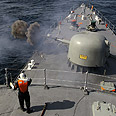
US, Israel to hold anti-mine drills in 'Mideast waterways'
Commander of US military's Central Command says exercise to focus on keeping oil shipping lanes open in case Iran, terror groups deploy mines to disrupt tanker traffic
The US military announced on Monday an anti-mine exercise in "the Middle East's international waterways" in May with more than 20 nations participating, the latest show of global will to keep waterways open as tensions with Iran simmer.
Israel's Navy is also expected to take part in the drill, which was characterized as defensive and a follow-up to the IMCMEX 12 exercise held last September, focused on keeping oil shipping lanes open by clearing mines that potentially Iran, or even terror groups, might deploy to disrupt tanker traffic.
Related articles:
- Iran claims 'dozens' of its drones reached Israel
- Iran holds exercises in Strait of Hormuz
- Op-ed: President Obama, talk to Iran
"This year's effort will reaffirm the ongoing, global cooperation that this mission enjoys with the international community's strong support for free trade," General James Mattie, commander of the US military's Central Command, said in a statement.
US officials have in the past sought to play down any link between the drills and ongoing tensions with Iran, which is pushing forward with a nuclear program the West fears is aimed at giving it the capability to build an atomic bomb. Tehran says the program is peaceful.
But the anti-mine exercises are widely seen as a clear show of determination by a broad coalition of states to counter any attempt Iran might make to disrupt Gulf shipping in response to an Israeli or US strike on its nuclear facilities - a form of retaliation Iran has repeatedly threatened.
In January Iran held a five-day sea maneuver near the strategic Strait of Hormuz, during which it fired a "Ghader" anti-ship missile with a range of 200 kilometers (120 miles). The Iranians claim the missile is capable of sinking large warships.
The Strait of Hormuz, which is located between Oman and Iran, connects the Persian Gulf with the Gulf of Oman and the Arabian Sea. At its narrowest point, the Strait is 21 miles wide, but the width of the shipping lane in either direction is only two miles, separated by a two-mile buffer zone.
According to the US Energy Information Administration, in 2009 some 33% of all seaborne traded oil, or 17% of all oil traded worldwide, flowed through the Strait.
Over the past few years Iran has repeatedly threatened to close the Strait, prompting the US to send another aircraft carrier to the region.
Central Command said the drill in May, IMCMEX 13, would focus on mine countermeasures, as well as maritime security operations and protecting maritime infrastructure. It did not provide further details.










